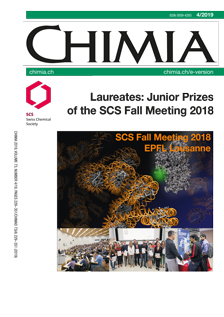A Diversity of Asymmetric Nano-/Microcolloidal Architectures Grown by ATRP from Janus Seeds
DOI:
https://doi.org/10.2533/chimia.2019.324PMID:
30975265Keywords:
Anisotropic colloids, Atrp, Janus nanoparticles, Surface nanostructuresAbstract
The fabrication of colloids has witnessed significant progress during the last decade, however, fabrication of anisotropic colloidal particles with complex geometries still represents a challenging task. Here, we present nano-/micro-sized colloidal architectures which 'grow' directly from nanoparticle seeds by controlled radical polymerization, resembling the growth of plants from seeds in the natural world. Specifically, we use the atom transfer radical polymerization (ATRP) technique to grow colloidal architectures from snowman-shaped Janus nanoparticle seeds (JNPS). The key to this synthetic approach is the asymmetric placement of the ATRP initiators in the bulk of one JNPS lobe. By starting the polymerization, monomers continuously add to the initiator containing the JNPS lobe, which subsequently grows into a larger colloidal structure. By controlling growth conditions mainly through the interaction strength between the monomer and JNPS, a variety of colloidal architectures result, for example, dish-, basket, cocoon-, flower-, helmet- mushroom-, dumpling and pumpkin-like geometries. Furthermore, each of these grown architectures have different surface morphologies, including smooth-, island- and grouped island nanostructures. The present work provides an alternative method to the synthesis of anisotropic particles with complex geometries and tunable surface morphologies, thus enriching the toolbox for the colloid synthesis.Downloads
Published
2019-04-24
Issue
Section
Scientific Articles
License
Copyright (c) 2019 Swiss Chemical Society

This work is licensed under a Creative Commons Attribution-NonCommercial 4.0 International License.
How to Cite
[1]
Chimia 2019, 73, 324, DOI: 10.2533/chimia.2019.324.







